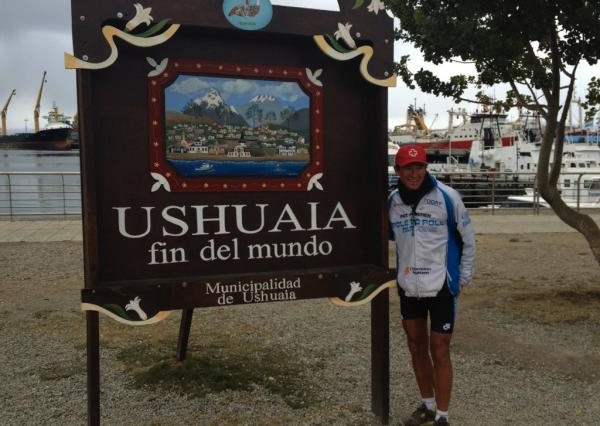Ultra-marathon runner Pat Farmer tweeted “20,919km covered in 10 months 13 days from one end of the earth to the other. I’ve finished @poletopolerun thank you!”and this photo the day he finished the Pole to Pole Run. Photograph courtesy of Pole to Pole Run’s Twitter account.
It’s not a small world after all, for ultra-marathon runner Pat Farmer.
You may remember reading our February 2011 profile of the Australian, who was on a mission to run pole to pole in 11 months. Like many people, at first I had my doubts. Running two marathons in one day? Burning 12,000 calories daily? Impossible.
But when I met Farmer in DC before he shipped off to the North Pole, it wasn’t hard for him to convince me that this crazy trek was completely worth it. The former Australian Parliament member was running to save lives and to raise money for the International Red Cross. So far, donations for Red Cross Australia and several other Red Cross branches in North America are still coming in; by this morning the figure from Australia alone was at $120,000.
Ten months, 13 days, 12,998 miles, 19 pounds, and 22 pairs of shoes later, Farmer is back home in Sydney. He’s mostly grateful to be reunited with his two children, Brooke and Dillon, who are 16 and 14, and whom Farmer only saw twice last year. One time was in Atlanta to experience a true American Fourth of July, while another was before he ran into the dangerous Darien Jungle (“I was very concerned about the jungle and what possibly could happen to me,” he says).
I caught up with Farmer this weekend, and he shared his memories, both good and bad—running the bases at an Atlanta Braves game on July 4, getting infected toes from traversing the jungle, and surviving his lowest points of the trip.
Read on to find out why even after his epic, incredibly grueling journey, he’s not ready to hang up his running shoes just yet.
How he feels right now:
“Physically, I’ve just got a couple of little aches and pains. But otherwise, considering the distance I’ve covered, mentally I’m in a whole different world. I’m not sure I fit into this world . . . it’s made me appreciate that everything in life is really epic.”

One of Pat’s lowest points of the trek:
The start of the trip in the North Pole. “I was just hit with the shock of being in the North Pole in absolute blizzard conditions. All of my clothes were covered in ice—I was putting on cold clothing just to start the day, and it was incredibly depressing.”
“I had a face mask that I normally wore, but it was frozen solid. I needed to get the thing back on because my face was getting frostbitten. So I poured so boiling water over the face mask, but unfortunately it froze instantly to my face. By the end, the skin of my face came off. It was a while before that repaired . . . it was moments like that where you just ask yourself, ‘Is it really worth it?’”
Awful injuries:
“The Colombian Red Cross came out to meet me and noticed I was limping. They looked at my feet, and they were badly poisoned. They lacerated the toes and squeezed poison out. It was a pretty rough procedure and a lot of pain, since there was no anesthetic.”
“There were so many other injuries along the way—the tendons in the backs of my knees, and I tore my Achilles tendon. I was so heavily inflamed and swollen for weeks on end.”
Scariest place to run:
Panama’s Darien Jungle. “I was warned a lot about the Darien, quite rightly. There are a lot of people there who have issues with the government in Colombia and Panama. For that reason, the Panamanian government gave me armed personnel to trek with me, equipped with machine guns—really, every firearm you could possibly imagine.”
“A couple of things happened during the course of time through there. Because it’s a tropical jungle, we experienced severe flooding in an number of spots. And when you get the heavy rains like that, all the snakes move uphill, so we came across a lot of those. And of course, [the jungle] is renowned for kidnappings. This is the thing the army was most concerned about: that people would take me as a hostage.”

Near-death moment:
“We were dragging sleds through [the North Pole]. My cameraman fell through the ice, and we had to disrobe him, set up a tent, get the stove going, get his clothes off, and put him in a sleeping bag as quickly as possible. That day we only did five kilometers because we spent rest of the day hoping he would survive.”
Most welcoming place to run:
The South. “People told me about Southern hospitality, and in North and South Carolina and all through that region, we were welcomed with open arms. People would bring me food and pies out on the road, or I’d be joined by people. Often on the highway, traffic would be backed up, and people would be yelling out of their cars, cheering me on.”
What’s next for Pat?
“There are a couple of things. One is, as much as I hate the cold, I did very well in the North and South poles. There’s a record held by a Norwegian who ran the entire South Pole and back. It took him three months to do that. It only took me 20 days to run there, so that’s something I might look at in the future.”
“For the short term, I’m going to try to do as much as I can with the Red Cross and try to support them. I’ve also got a book and a documentary coming out about this whole thing.”


















